Jipeng Zhang
MA-LoT: Multi-Agent Lean-based Long Chain-of-Thought Reasoning enhances Formal Theorem Proving
Mar 05, 2025Abstract:Solving mathematical problems using computer-verifiable languages like Lean has significantly impacted mathematical and computer science communities. State-of-the-art methods utilize single Large Language Models (LLMs) as agents or provers to either generate complete proof or perform tree searches. However, single-agent methods inherently lack a structured way to combine high-level reasoning in Natural Language (NL) with Formal Language (FL) verification feedback. To solve these issues, we propose MA-LoT: Multi-Agent Lean-based Long Chain-of-Thought framework, (to the best of our knowledge), the first multi-agent framework for Lean4 theorem proving that balance high-level NL reasoning and FL verification in Long CoT. Using this structured interaction, our approach enables deeper insights and long-term coherence in proof generation, with which past methods struggle. We do this by leveraging emergent formal reasoning ability in Long CoT using our novel LoT-Transfer Learning training-inference pipeline. Extensive experiments show that our framework achieves 54.51% accuracy rate on the Lean4 version of MiniF2F-Test dataset, largely outperforming GPT-4 (22.95%), single-agent tree search (InternLM-Step-Prover, 50.70%), and whole-proof generation (DeepSeek-Prover-v1.5, 48.36%) baselines. Furthermore, our findings highlight the potential of combining Long CoT with formal verification for a more insightful generation in a broader perspective.
Adapt-Pruner: Adaptive Structural Pruning for Efficient Small Language Model Training
Feb 05, 2025Abstract:Small language models (SLMs) have attracted considerable attention from both academia and industry due to their broad range of applications in edge devices. To obtain SLMs with strong performance, conventional approaches either pre-train the models from scratch, which incurs substantial computational costs, or compress/prune existing large language models (LLMs), which results in performance drops and falls short in comparison to pre-training. In this paper, we investigate the family of acceleration methods that involve both structured pruning and model training. We found 1) layer-wise adaptive pruning (Adapt-Pruner) is extremely effective in LLMs and yields significant improvements over existing pruning techniques, 2) adaptive pruning equipped with further training leads to models comparable to those pre-training from scratch, 3) incremental pruning brings non-trivial performance gain by interleaving pruning with training and only removing a small portion of neurons ($\sim$5%) at a time. Experimental results on LLaMA-3.1-8B demonstrate that Adapt-Pruner outperforms conventional pruning methods, such as LLM-Pruner, FLAP, and SliceGPT, by an average of 1%-7% in accuracy on commonsense benchmarks. Additionally, Adapt-Pruner restores the performance of MobileLLM-125M to 600M on the MMLU benchmark with 200$\times$ fewer tokens via pruning from its larger counterparts, and discovers a new 1B model that surpasses LLaMA-3.2-1B in multiple benchmarks.
SafetyDPO: Scalable Safety Alignment for Text-to-Image Generation
Dec 13, 2024Abstract:Text-to-image (T2I) models have become widespread, but their limited safety guardrails expose end users to harmful content and potentially allow for model misuse. Current safety measures are typically limited to text-based filtering or concept removal strategies, able to remove just a few concepts from the model's generative capabilities. In this work, we introduce SafetyDPO, a method for safety alignment of T2I models through Direct Preference Optimization (DPO). We enable the application of DPO for safety purposes in T2I models by synthetically generating a dataset of harmful and safe image-text pairs, which we call CoProV2. Using a custom DPO strategy and this dataset, we train safety experts, in the form of low-rank adaptation (LoRA) matrices, able to guide the generation process away from specific safety-related concepts. Then, we merge the experts into a single LoRA using a novel merging strategy for optimal scaling performance. This expert-based approach enables scalability, allowing us to remove 7 times more harmful concepts from T2I models compared to baselines. SafetyDPO consistently outperforms the state-of-the-art on many benchmarks and establishes new practices for safety alignment in T2I networks. Code and data will be shared at https://safetydpo.github.io/.
WSI-LLaVA: A Multimodal Large Language Model for Whole Slide Image
Dec 03, 2024



Abstract:Recent advancements in computational pathology have produced patch-level Multi-modal Large Language Models (MLLMs), but these models are limited by their inability to analyze whole slide images (WSIs) comprehensively and their tendency to bypass crucial morphological features that pathologists rely on for diagnosis. To address these challenges, we first introduce WSI-Bench, a large-scale morphology-aware benchmark containing 180k VQA pairs from 9,850 WSIs across 30 cancer types, designed to evaluate MLLMs' understanding of morphological characteristics crucial for accurate diagnosis. Building upon this benchmark, we present WSI-LLaVA, a novel framework for gigapixel WSI understanding that employs a three-stage training approach: WSI-text alignment, feature space alignment, and task-specific instruction tuning. To better assess model performance in pathological contexts, we develop two specialized WSI metrics: WSI-Precision and WSI-Relevance. Experimental results demonstrate that WSI-LLaVA outperforms existing models across all capability dimensions, with a significant improvement in morphological analysis, establishing a clear correlation between morphological understanding and diagnostic accuracy.
Fox-1 Technical Report
Nov 08, 2024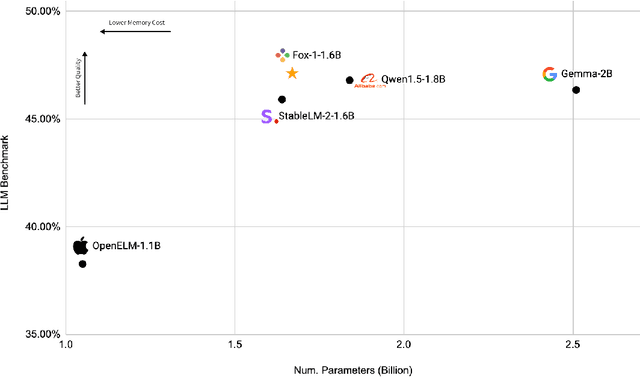

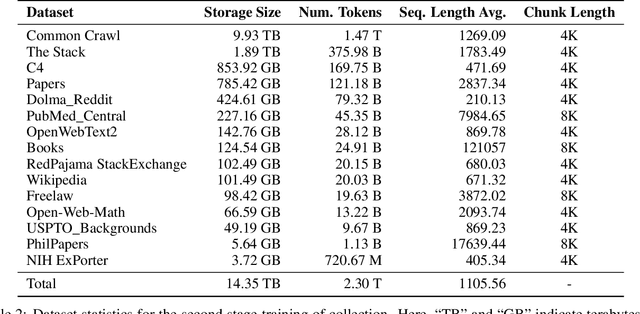
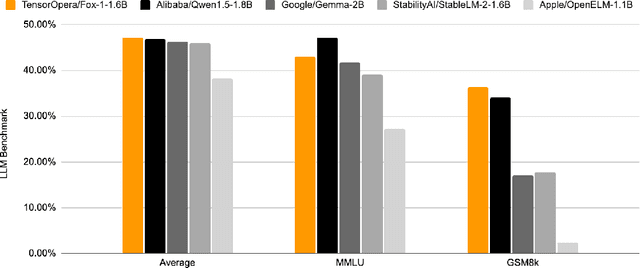
Abstract:We present Fox-1, a series of small language models (SLMs) consisting of Fox-1-1.6B and Fox-1-1.6B-Instruct-v0.1. These models are pre-trained on 3 trillion tokens of web-scraped document data and fine-tuned with 5 billion tokens of instruction-following and multi-turn conversation data. Aiming to improve the pre-training efficiency, Fox-1-1.6B model introduces a novel 3-stage data curriculum across all the training data with 2K-8K sequence length. In architecture design, Fox-1 features a deeper layer structure, an expanded vocabulary, and utilizes Grouped Query Attention (GQA), offering a performant and efficient architecture compared to other SLMs. Fox-1 achieves better or on-par performance in various benchmarks compared to StableLM-2-1.6B, Gemma-2B, Qwen1.5-1.8B, and OpenELM1.1B, with competitive inference speed and throughput. The model weights have been released under the Apache 2.0 license, where we aim to promote the democratization of LLMs and make them fully accessible to the whole open-source community.
Alopex: A Computational Framework for Enabling On-Device Function Calls with LLMs
Nov 07, 2024



Abstract:The rapid advancement of Large Language Models (LLMs) has led to their increased integration into mobile devices for personalized assistance, which enables LLMs to call external API functions to enhance their performance. However, challenges such as data scarcity, ineffective question formatting, and catastrophic forgetting hinder the development of on-device LLM agents. To tackle these issues, we propose Alopex, a framework that enables precise on-device function calls using the Fox LLM. Alopex introduces a logic-based method for generating high-quality training data and a novel ``description-question-output'' format for fine-tuning, reducing risks of function information leakage. Additionally, a data mixing strategy is used to mitigate catastrophic forgetting, combining function call data with textbook datasets to enhance performance in various tasks. Experimental results show that Alopex improves function call accuracy and significantly reduces catastrophic forgetting, providing a robust solution for integrating function call capabilities into LLMs without manual intervention.
Bridge-Coder: Unlocking LLMs' Potential to Overcome Language Gaps in Low-Resource Code
Oct 24, 2024
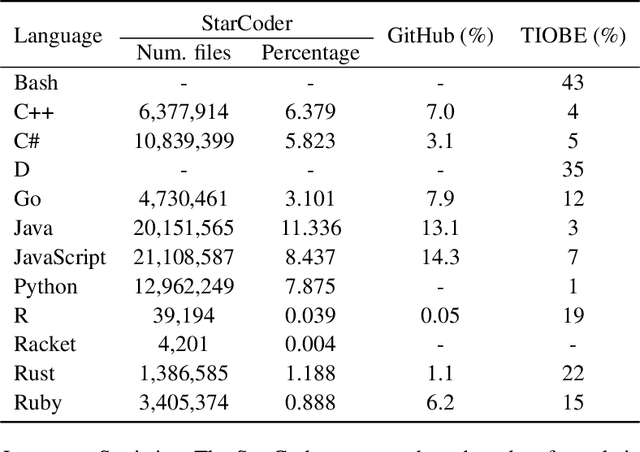

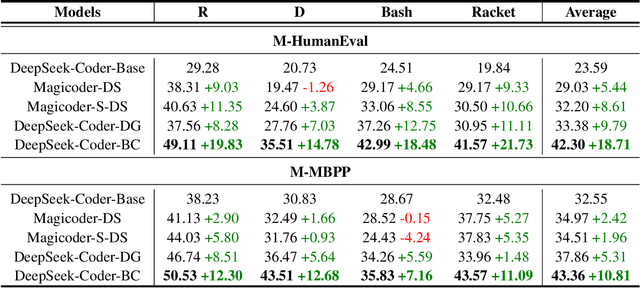
Abstract:Large Language Models (LLMs) demonstrate strong proficiency in generating code for high-resource programming languages (HRPLs) like Python but struggle significantly with low-resource programming languages (LRPLs) such as Racket or D. This performance gap deepens the digital divide, preventing developers using LRPLs from benefiting equally from LLM advancements and reinforcing disparities in innovation within underrepresented programming communities. While generating additional training data for LRPLs is promising, it faces two key challenges: manual annotation is labor-intensive and costly, and LLM-generated LRPL code is often of subpar quality. The underlying cause of this issue is the gap between natural language to programming language gap (NL-PL Gap), which is especially pronounced in LRPLs due to limited aligned data. In this work, we introduce a novel approach called Bridge-Coder, which leverages LLMs' intrinsic capabilities to enhance the performance on LRPLs. Our method consists of two key stages. Bridge Generation, where we create high-quality dataset by utilizing LLMs' general knowledge understanding, proficiency in HRPLs, and in-context learning abilities. Then, we apply the Bridged Alignment, which progressively improves the alignment between NL instructions and LRPLs. Experimental results across multiple LRPLs show that Bridge-Coder significantly enhances model performance, demonstrating the effectiveness and generalization of our approach. Furthermore, we offer a detailed analysis of the key components of our method, providing valuable insights for future work aimed at addressing the challenges associated with LRPLs.
Personalized Visual Instruction Tuning
Oct 09, 2024



Abstract:Recent advancements in multimodal large language models (MLLMs) have demonstrated significant progress; however, these models exhibit a notable limitation, which we refer to as "face blindness". Specifically, they can engage in general conversations but fail to conduct personalized dialogues targeting at specific individuals. This deficiency hinders the application of MLLMs in personalized settings, such as tailored visual assistants on mobile devices, or domestic robots that need to recognize members of the family. In this paper, we introduce Personalized Visual Instruction Tuning (PVIT), a novel data curation and training framework designed to enable MLLMs to identify target individuals within an image and engage in personalized and coherent dialogues. Our approach involves the development of a sophisticated pipeline that autonomously generates training data containing personalized conversations. This pipeline leverages the capabilities of various visual experts, image generation models, and (multi-modal) large language models. To evaluate the personalized potential of MLLMs, we present a benchmark called P-Bench, which encompasses various question types with different levels of difficulty. The experiments demonstrate a substantial personalized performance enhancement after fine-tuning with our curated dataset.
PolyRouter: A Multi-LLM Querying System
Aug 26, 2024



Abstract:With the rapid growth of Large Language Models (LLMs) across various domains, numerous new LLMs have emerged, each possessing domain-specific expertise. This proliferation has highlighted the need for quick, high-quality, and cost-effective LLM query response methods. Yet, no single LLM exists to efficiently balance this trilemma. Some models are powerful but extremely costly, while others are fast and inexpensive but qualitatively inferior. To address this challenge, we present PolyRouter, a non-monolithic LLM querying system that seamlessly integrates various LLM experts into a single query interface and dynamically routes incoming queries to the most high-performant expert based on query's requirements. Through extensive experiments, we demonstrate that when compared to standalone expert models, PolyRouter improves query efficiency by up to 40%, and leads to significant cost reductions of up to 30%, while maintaining or enhancing model performance by up to 10%.
FIRST: Teach A Reliable Large Language Model Through Efficient Trustworthy Distillation
Aug 22, 2024Abstract:Large language models (LLMs) have become increasingly prevalent in our daily lives, leading to an expectation for LLMs to be trustworthy -- - both accurate and well-calibrated (the prediction confidence should align with its ground truth correctness likelihood). Nowadays, fine-tuning has become the most popular method for adapting a model to practical usage by significantly increasing accuracy on downstream tasks. Despite the great accuracy it achieves, we found fine-tuning is still far away from satisfactory trustworthiness due to "tuning-induced mis-calibration". In this paper, we delve deeply into why and how mis-calibration exists in fine-tuned models, and how distillation can alleviate the issue. Then we further propose a brand new method named Efficient Trustworthy Distillation (FIRST), which utilizes a small portion of teacher's knowledge to obtain a reliable language model in a cost-efficient way. Specifically, we identify the "concentrated knowledge" phenomenon during distillation, which can significantly reduce the computational burden. Then we apply a "trustworthy maximization" process to optimize the utilization of this small portion of concentrated knowledge before transferring it to the student. Experimental results demonstrate the effectiveness of our method, where better accuracy (+2.3%) and less mis-calibration (-10%) are achieved on average across both in-domain and out-of-domain scenarios, indicating better trustworthiness.
 Add to Chrome
Add to Chrome Add to Firefox
Add to Firefox Add to Edge
Add to Edge